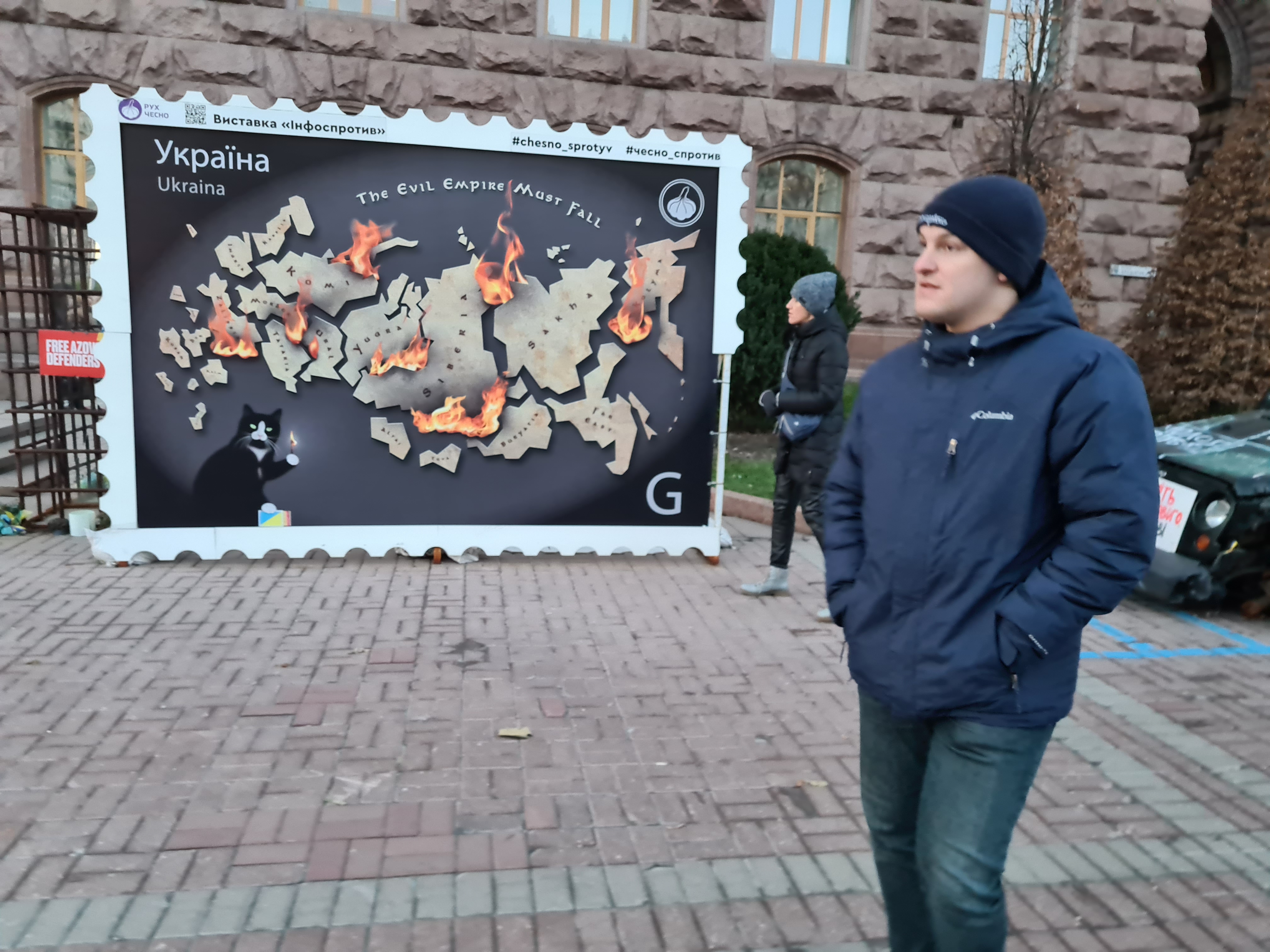
Kyiv, Ukraine – Artem Honcharuk turns off the lights and switches on two halogen lamps to illuminate the black plastic letters on his shop’s wall that read “copy centre” in Ukrainian.
More than a year ago, he tinkered with these lamps so they could run on batteries and light up his print shop in an underground shopping mall in central Kyiv.
“That’s the light I was working under,” the 31-year-old told Al Jazeera, standing next to a desktop computer, copy machines and printers. “I already forgot how it was.”
In the winter of late 2022 and early 2023, Moscow rained hell on Ukraine, targeting civilian infrastructure to deprive residents of power, central heating, water – and the will to fight back.
Andriy Kostin, the prosecutor general of Ukraine, called it “terrorism and war crimes” at the time.
Each air raid began with dozens of slow, noisy, Iranian-made Shahed drones laden with up to 50kg (110 pounds) of explosives.
Experienced shooters took many down, but the drones were followed by ballistic missiles, and in some cases, supersonic cruise missiles launched from strategic bombers midair in western Russia.
Bombing intensified after Russian forces withdrew from around Kyiv, northern Ukraine, and several areas in the east and south, losing tens of thousands of servicemen and faith in President Vladimir Putin’s blitzkrieg.
Between October 10, 2022 and March 9, 2023, the shelling took place every single day, often lasting hours, killing and wounding hundreds and keeping millions awake and horrified.
After depleting its stashes, Moscow struck less frequently – but would amass the missiles and drones to make each new one more lethal.
Many strikes succeeded – fully or partly – destroying power, transmission and central heating stations all over Ukraine, as well as apartment buildings and hospitals.

The damage led to blackouts, disruptions of central heating, and water supply when entire districts went black, and cold, for several days.
An average Ukrainian household went through five cumulative weeks without power in the winter of 2022-23, the United Nations said.
Russia hit Ukrainian energy infrastructure 271 times, Herman Halushchenko, Ukraine’s energy minister, said in July 2023, adding that the overall damage was estimated at $11bn.
What his ministry did not estimate is the damage to tens of thousands of small businesses, such as Honcharuk’s.
Ukraine’s preparation
Ukraine had been preparing for a similarly harsh winter, as Russia resumed the shelling in the autumn.
Energy infrastructure was covered with sandbags, concrete slabs and metal cages or moved underground. Power supply to nine million people was restored.
Kyiv now also has two Patriots, the most advanced US-made air defence systems that can intercept the hypersonic Kinzhal cruise missiles that Putin casts as “indestructible”.
But each Patriot missile costs $4m, and the United States recently warned that there would be a shortage of supplies. Washington also supplied Hawks, the decades-old predecessors of Patriots, and Gepart antiaircraft tanks.
Ukraine has US-made National Advanced Surface-to-Air Missile Systems (NASAMs), too, just like the ones that protect the White House, as well as similar, German-made IRIS-T systems.
Some analysts say the effectiveness of Russian strikes on Kyiv is minimal; there has not been a single blackout in Honcharuk’s shop and apartment building this winter.
Even so, the shopkeeper got used to the deafening blasts of air defence missiles that guard his residential area.
“Even if the missiles fly around loudly, I just turn and go back to sleep,” said Honcharuk. “There’s no more fear now, absolutely.”
New Russian tactics
But the Kremlin has not given up on strikes and “looks for ways to improve effectiveness” by using various combinations of drones and missiles, a military expert said.
Russians invent complicated routes for cruise missiles to zigzag over Ukraine bypassing areas covered by air defence and hitting their targets from unexpected directions, said Lieutenant-General Ihor Romanenko, the former deputy chief of Ukraine’s General Staff of the Armed Forces.
Realising that Western air defence systems in Kyiv shoot down almost all of their missiles and drones, Russians focus on other urban areas such as the eastern cities of Dnipro and Kryvyi Rih, he said.
“The morning of December 29 was horrendous,” Ihor Kolesnichenko, an engineer from Dnipro, told Al Jazeera, describing the air raid that killed six, wounded three dozen and damaged a maternity hospital.

That day, Russia used 110 missiles and 36 drones to hit 18 cities and towns, killing 58 and wounding 158 in what became the most lethal attack of 2023, Ukrainian officials said.
Russians started painting some drones black for night-time attacks, and replaced their propellers with jet engines so that they fly at 500kmph (310mph), Romanenko said.
On December 30, they started launching short-range missiles allegedly made in North Korea.
“They strike to pressure our citizens morally, psychologically so that they urge our leaders to start peace talks, to stop hostilities, which means the legalisation of occupation” in eastern and southern Ukraine, Romanenko said.
‘The most difficult part’
Starting in late 2022, blackouts plunged Honcharuk’s print shop into darkness while prices for consumables such as printer ink surged three to four times.
The cold was often paralysing with no central heating. But Honcharuk turned lemons into lemonade.
Since his shop was underground, he did not have to close down during air raids, and people sitting them out would drop by to copy a document, get a printout or take a photo.
He spent about $1,000 on a power generator, lamps and other accessories but did not raise prices because the mall’s owner gave him a discount on rent.
“The most difficult part was to take people’s pictures in darkness. The flash blinds me and them, and I don’t see the second shot,” Honcharuk said.
Two metres of soil and asphalt above his shop, the Western defence system near his apartment building in southwestern Kyiv, made him feel safe from the shelling, but not from the cold. Millions of Ukrainians had to sleep fully clothed with sweaters, coats and two pairs of socks.
They stocked up on power banks, candles, flashlights and thermoses, and meticulously charged every gadget when electricity was back on, sometimes just for a couple of hours a day.
The winter sun set before 6pm, snow and ice turned dark streets into ice rinks, and only mobile phone flashlights saved people from falling.
“It was the worst winter of our lives,” said Kateryna Ivanenko, a tax lawyer and mother-of-two whose six-year-old son Ihor barely survived pneumonia in February. “I want all Russians to live through a winter like that, that’s the very least they deserve.”
During the blackouts, Ukrainians flocked to subway stations, shopping malls, or cafes that had power generators and often offered power sockets free of charge.
They exchanged lifehacks on how to preserve food, such as hanging it in bags outside their windows or placing plastic bottles with water in their freezers.
This winter, Honcharuk “expected the same”.
“What kept me warm was that I was ready,” he said.







